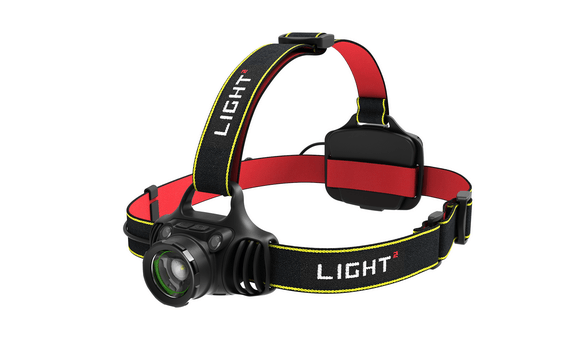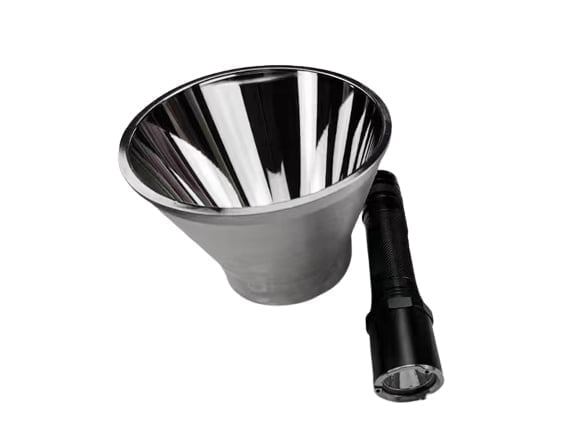If you are in the business of portable outdoor lighting, you may wonder which type of lighting tool, between flashlights and headlamps, has better sales.
When it comes to choosing between a flashlight and a headlamp, it can be a difficult decision to make for consumers. Both have advantages and disadvantages, and the choice often comes down to personal preference and intended use. This article will explore the pros and cons of flashlights and headlamps to help you make an informed decision.
As a professional manufacturer, I would like to share the differences between flashlights and headlamps in terms of structure and performance. Please see below for details.
Structure
Flashlights are handheld devices that produce a beam of light. They come in various sizes and shapes, some designed to fit in a pocket or on a keychain, while others are large and require both hands to hold. Typically, flashlights have larger internal dimensions than headlamps, allowing for larger batteries, circuit boards, and LED chips.
In comparison, the size of a headlamp cannot be as large as a flashlight, and the internal space is very limited. Designing and producing a headlamp is much more challenging than a flashlight.
Weight
The weight of a flashlight can vary from light to heavy. Everyday carry flashlights typically require a lighter weight. However, good quality flashlights on the market usually weigh around 300 grams, while some special-purpose flashlights that require high brightness and long battery life can weigh 1000 grams or more.
Considering that a headlamp is worn on the head for a long time, its weight cannot be too heavy. There are also heavier headlamps on the market, such as the LL model that uses 2*21700 batteries, but these heavy-duty headlamps require a top strap to share the weight.

Generally, headlamps without a top strap that weigh around 200 grams are more comfortable.

Battery Capacity
Flashlights typically use cylindrical batteries, such as AA, AAA, 14500, 18650, 21700, and 26650. The flashlight can be powered by a single battery or multiple batteries.
Headlamps usually use flat battery packs, such as 832937, and 104040, which are generally smaller than the 18650 battery size. The battery box of the headlamp can be located in the front of the head, just like the LED chip, or it can be located at the back of the head. The battery size of the headlamp is generally smaller than that of the flashlight, so the battery capacity is also smaller. Since flashlight batteries are generally larger than headlamp batteries, their battery life is usually longer.
Brightness
The brightness of flashlights can reach 10,000 lumens or higher, which requires high energy to support. Flashlight batteries are relatively large so that they can support high brightness.
It’s difficult to imagine a headlamp that can reach 4,000 lumens; currently, headlamps on the market generally have a maximum of 2,000 lumens. Because of their smaller battery size, brief high brightness has no practical use, and excessively high brightness also generates more heat, which poses a challenging problem for the heat dissipation of small headlamps. The actual useful brightness of headlamps is generally around 1,000 lumens.
Beam distance
Flashlights can use extra-long reflective cups, which allow them to focus and achieve longer ranges.

Headlamps cannot use long reflective cups, therwise, the head of the headlamp will protrude too far, which looks visually strange.
Manufacturing Cost
Because flashlights use aluminum alloy shells, their material costs are generally higher than those of headlamps.
However, the start-up cost of headlamps is more expensive because headlamps contain more plastic accessories or brackets, so their mold costs are higher than those of flashlights. For factories, the cost of investing in a headlamp is more than twice as high as that of a flashlight. For consumers, the unit price of headlamps will be slightly lower than that of flashlights with the same performance.
Durability
The outer shell of flashlights is usually all aluminum alloy, and some high-quality flashlights have thick shells that can withstand being run over by cars or even trucks.
The outer shell of headlamps is usually only aluminum alloy around the LED chip, while other brackets and battery boxes are usually made of plastic.
Diversity
Flashlights can be made in various sizes and with various functions, from small keychain sizes to large shoulder-mounted sizes.
The size difference between headlamps is insignificant, so the diversity of headlamps is much less than that of flashlights.
Convenience
When using a flashlight for illumination, it needs to be held in hand and cannot support two-handed work.
A headlamp worn on the head frees up both hands to do more meaningful things.
Comfort
Flashlights are generally comfortable to use, and if your left hand gets tired, you can switch to your right hand and vice versa.
Wearing a headlamp for a long time can feel uncomfortable for various reasons, such as plastic parts not conforming to the curvature of the head, poor heat dissipation causing overheating, the weight of the headlamp itself being too heavy or unbalanced, the headlamp strap material being non-breathable, the headlamp strap being too hard or too tight, etc.
Trends
Headlamps and flashlights serve different purposes and are popular in their respective applications.
Headlamps are commonly used in outdoor activities such as working, hiking, camping, and caving, where hands-free lighting is necessary. They are also popular among runners and cyclists who need to see and be seen at night.
On the other hand, flashlights are more versatile and can be used in a wider range of situations, such as household emergencies, car maintenance, and exploring dark areas where a headlamp may not be as practical.
Overall, it’s difficult to say which is more popular as it depends on the specific needs and preferences of the user. Both headlamps and flashlights have their place in different contexts and are widely used by people around the world.
But based on our years of manufacturing experience, we can feel that people are slightly more willing to buy a headlamp than a flashlight. After all, they need to be hand free in most activities. Headlamps are suitable for everyday use by most people. But the versatility of flashlights makes them more suitable for some specific professions that require higher brightness, range, and battery life. These professionals may choose a flashlight because the mouth can hold the flashlight in an emergency where both hands are needed.
Regardless of your choice, be sure to purchase a high-quality flashlight that can perform the job perfectly and consistently. Avoid choosing cheap flashlights as they may provide a worse experience than darkness.
If you are in the business of portable outdoor lighting, you may wonder which type of lighting tool, between flashlights and headlamps, has better sales.
When it comes to choosing between a flashlight and a headlamp, it can be a difficult decision to make for consumers. Both have their advantages and disadvantages, and the choice often comes down to personal preference and intended use. In this article, we will explore the pros and cons of both flashlights and headlamps to help you make an informed decision.
As a professional manufacturer, I would like to share with you the differences between flashlights and headlamps in terms of structure and performance. Please see below for details.
Structure
Flashlights are handheld devices that produce a beam of light. They come in various sizes and shapes, some designed to fit in a pocket or on a keychain, while others are large and require both hands to hold. Typically, flashlights have larger internal dimensions than headlamps, allowing for larger batteries, circuit boards, and LED chips.
In comparison, the size of a headlamp cannot be as large as a flashlight, and the internal space is very limited. Designing and producing a headlamp is much more challenging than a flashlight.
Weight
The weight of a flashlight can vary from light to heavy. Everyday carry flashlights typically require a lighter weight. However, good quality flashlights on the market usually weigh around 300 grams, while some special-purpose flashlights that require high brightness and long battery life can weigh 1000 grams or more.
Considering that a headlamp is worn on the head for a long time, its weight cannot be too heavy. There are also heavier headlamps on the market, such as the LL model that uses 2*21700 batteries, but these heavy-duty headlamps require a top strap to share the weight. Generally, headlamps without a top strap that weigh around 200 grams are more comfortable.
Battery Capacity
Flashlights typically use cylindrical batteries, such as AA, AAA, 14500, 18650, 21700, 26650. The flashlight can be powered by a single battery or multiple batteries.
Headlamps usually use flat battery packs, which are generally smaller than the 18650 battery size. The battery box of the headlamp can be located in the front of the head, just like the LED chip, or it can be located at the back of the head. The battery size of the headlamp is generally smaller than that of the flashlight, so the battery capacity is also smaller. Since flashlight batteries are generally larger than headlamp batteries, their battery life is usually longer.
Brightness
The brightness of flashlights can reach 10,000 lumens or higher, which requires high energy to support. Flashlight batteries are relatively large, so they can support high brightness.
It’s difficult to imagine a headlamp that can reach 4,000 lumens, and currently, headlamps on the market generally have a maximum of 2,000 lumens. Because of their smaller battery size, brief high brightness has no practical use, and excessively high brightness also generates more heat, which poses a challenging problem for the heat dissipation of small headlamps. The actual useful brightness of headlamps is generally around 1,000 lumens.
Range
Flashlights can use extra-long reflective cups, which allow them to focus and achieve longer ranges.
Headlamps cannot use long reflective cups, otherwise the head of the headlamp will protrude too far, which looks visually strange.
Manufacturing Cost
Because flashlights use aluminum alloy shells, their material costs are generally higher than those of headlamps.
However, the start-up cost of headlamps is more expensive because headlamps contain more plastic accessories or brackets, so their mold costs are higher than those of flashlights. For factories, the cost of investing in a headlamp is more than twice as high as that of a flashlight. For consumers, the unit price of headlamps will be slightly cheaper than that of flashlights with the same performance.
Durability
The outer shell of flashlights is usually all aluminum alloy, and some high-quality flashlights have thick shells that can withstand being run over by cars or even trucks.
The outer shell of headlamps is usually only aluminum alloy around the LED chip, while other brackets and battery boxes are usually made of plastic.
Diversity
Flashlights can be made in various sizes and with various functions, from small keychain size to large shoulder-mounted size.
The size difference of headlamps is not significant, so the diversity of headlamps is much less than that of flashlights.
Convenience
When using a flashlight for illumination, it needs to be held in the hand and cannot support two-handed work.
A headlamp worn on the head frees up both hands to do more meaningful things.
Comfort
Flashlights are generally comfortable to use, and if your left hand gets tired, you can switch to your right hand, and vice versa.
Wearing a headlamp for a long time can feel uncomfortable for various reasons, such as plastic parts not conforming to the curvature of the head, poor heat dissipation causing overheating, the weight of the headlamp itself being too heavy or unbalanced, the headlamp strap material being non-breathable, the headlamp strap being too hard or too tight, etc.
Trends
Headlamps and flashlights serve different purposes and are popular in their respective applications.
Headlamps are commonly used in outdoor activities such as working, hiking, camping, and caving, where hands-free lighting is necessary. They are also popular among runners and cyclists who need to see and be seen at night.
On the other hand, flashlights are more versatile and can be used in a wider range of situations, such as household emergencies, car maintenance, and exploring dark areas where a headlamp may not be as practical.
Overall, it’s difficult to say which is more popular as it depends on the specific needs and preferences of the user. Both headlamps and flashlights have their place in different contexts and are widely used by people around the world.
Based on our years of manufacturing experience, we can feel that people are slightly more willing to buy a headlamp than a flashlight., after all they need to be hand free in most activities. Headlamps are suitable for everyday use for ordinary people. The versatility of flashlights makes them more suitable for some specific professions that require higher brightness, range, and battery life. These professionals may choose a flashlight because, in an emergency where both hands are needed, the mouth can hold the flashlight.
Regardless of your choice, be sure to purchase a high-quality flashlight that can perform the job perfectly and consistently. Avoid choosing cheap flashlights as they may provide you a worse experience than darkness.



49 Responses
rptbqjvxt sdidj hgcjhso kqmx pvcdsynocxprvka
131946 461218It is really a cool and helpful piece of info. Im glad which you shared this useful details with us. Please maintain us informed like this. Thanks for sharing. 309067
782211 25478I believe this web site contains some very good information for everybody : D. 863262